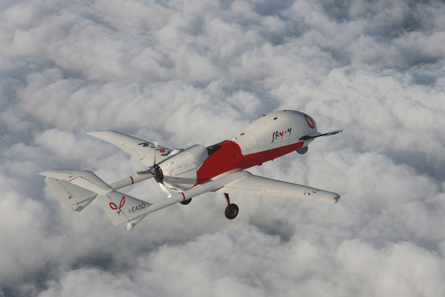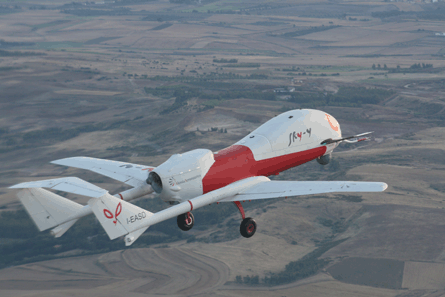With the recent fourth flying campaign of Alenia Aeronautica's Sky-Y unmanned air system, Finmeccanica-owned Selex Communications gained the first operational opportunity to evaluate its newly developed wideband datalink line-of-sight (WBDL-LOS) capability.
Stefano Lontaro, director of Selex Communications' avionics business unit, describes WBDL-LOS as "a new-generation, high-performance Ku-band WBDL solution for line-of-sight video/images/data/voice transmission at speeds of up to 45Mbps between airborne manned and unmanned platforms and a ground station, at altitudes up to 45,000ft [13,720m] and at a distance in excess of 100nm [185km]".
WBDL-LOS allows exchange of data/voice in the uplink direction as a means of controlling the airborne terminal or other equipment and functions on board the aircraft. In UAS applications, it supports the platform remote control and the bidirectional relay of audio between the UAS pilot and the air traffic control personnel.
 |
|---|
© Alenia Aeronautica |
The export version of WBDL-LOS in now in the process of being qualified and is to be followed by a compliant version with NATO's STANAG 7085 interoperability standards to be available in late 2011 or early 2012, says Lontaro.
These versions feature an airborne directional antenna with pointing capability and a high-gain, tracking ground antenna, but Selex Communications is already working on a satellite version. This will be the company's "satcom on the move" capabilities, which "according to current plans can be ready in a prototype model in two years' time", says Lontaro.
Selex Communications has a "strong past record in datalink integration", he insists, citing the multifunctional information distribution system (MIDS) interface unit provided for the Eurofighter Typhoon and Panavia Tornado plus the multi-link interface unit (MLIU) more recently provided for Italian ATR 72MP maritime patrol.
"The MLIU will be also installed on the [AgustaWestland] AW101 CSAR [combat search and rescue] platform to be acquired by Italian air force," he adds.
An enhanced version of Selex's datalink management system (DLMS) is meanwhile being developed with the aim of integrating various new-generation datalink systems in a single, flexible environment. This would enable real net-centric communications in airborne applications where the use of multiple, heterogeneous datalinks is necessary to guarantee the mission success.
 |
|---|
© Alenia Aeronautica |
Scheduled to be available in 2011, the enhanced DLMS will be based on Arinc 653 integrated modular avionics architecture to ensure easy customisation for different platforms and applications, and is intended to make multiple, differentiated datalink systems "totally transparent to the airborne and ground users by providing them a sort of common logical interface with the communication system", says Selex.
Specifically, the new DLMS makes internet protocol (IP)-based communications services available to users and provides layer/protocol adaptation between legacy or non-IP communication systems (for example, Link 11/16 tactical datalinks or air traffic management and control networks) and new-generation, IP-based datalink systems such as the WBDL-LOS.
It also includes features for protecting the information in accordance with recent military standards such as IP-based encryption and the "protected core network" concept. Automatic co-ordination between the UAS and the ground control station facilitates air vehicle handover between different stations and data link loss recovery.
Source: Flight Daily News
















